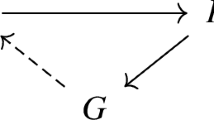Abstract
Groups with isomorphic holomorphs are said to be holomorphically isomorphic. The following problems are treated.
-
(1)
What Abelian groups have the property that their holomorphic isomorphism implies the isomorphism of the groups themselves?
-
(2)
Does holomorphic isomorphism of two groups, one of which is Abelian, imply the commutativity of the other group?
Classes of groups are selected for which the answers to these questions are positive.
Similar content being viewed by others
References
W. H. Mills, “Multiple holomorphs of finitely generated abelian groups,”Trans. Amer. Math. Soc.,71, No. 3 379–392 (1951).
I. Kh. Bekker and S. F. Kozhukhov,Automorphisms of Torsion-Free Abelian Groups [in Russian], Izdat. Tomsk. Univ., Tomsk (1988).
L. Fuchs,Infinite Abelian Groups, Vol. 1, Academic Press, New York-London (1970).
H. Bass,Lectures and Topics in Algebraic K-Theory, Tata Institute of Fundamental Research, Bombay (1967).
Author information
Authors and Affiliations
Additional information
Translated fromMatematicheskie Zametki, Vol. 62, No. 3, pp. 343–350, September, 1997.
Translated by A. I. Shtern
Rights and permissions
About this article
Cite this article
Bekker, I.K., Nedov, V.N. On groups with isomorphic holomorphs. Math Notes 62, 288–295 (1997). https://doi.org/10.1007/BF02360869
Received:
Issue Date:
DOI: https://doi.org/10.1007/BF02360869




